
Most flagship smartphones can get you through a full day of regular use, and while manufacturers have managed to pack large batteries inside slim phones, expecting a comfortable two-day battery life isn’t the norm. What has helped tremendously is speeding up the time it takes to charge a smartphone. Samsung has lagged behind the competition with its charging speeds for several years, but not anymore. With the new Note 10 Plus, Samsung has armed it with a 25W charger in the box for fast charging.
How does it measure to some of the most popular phones today? We pitted the Note 10 Plus against the OnePlus 7 Pro, the Galaxy S10 Plus, the Google Pixel 3 XL, and the iPhone XS Max to see which phone charges the fastest.
The phones
But first, let’s break down the setup for the test and the phones. We used the included cable and adapter that comes in the box for all these devices. They were discharged to zero percent, and the test started at the same exact time for all of them. If you want a quick primer on how fast charging works, check out our explainer.
Among the brands here, OnePlus is best known for its speedy and proprietary Warp Charge technology, available on the OnePlus 7 Pro. It requires the brick and cable included in the box, and OnePlus claims just 20 minutes of charging will be “enough power to get you going.”

Next up is the Galaxy S10 Plus, which supports Qualcomm Quick Charge 2.0 (from 2015), and it should take under two hours to fully charge the device. Then there’s the Google Pixel 3 XL, which supports the open USB Power Delivery 2.0 standard. It has an 18W adapter in the box, and Google claims you can get “up to 7 hours of battery life in 15 minutes.”
The iPhone XS Max comes with a standard adapter and Lightning cable in the box — there’s nothing remarkable here. You can buy an 18W adapter and USB-C to Lightning cable separately to juice up the iPhone to full in around an hour and a half, but it will cost you $50.
Finally, the Samsung Galaxy Note 10 Plus comes with a 25W charger in the box supporting Power Delivery 3.0, and Samsung claims it should refill the phone in around an hour. If that’s not enough, you can buy a 45W charger for $50 for even faster charging.
The test
We periodically checked in on all the phones at various times but marked down the percentage of each at the 10-minute mark, the 30-minute mark, as well as the 45-minute mark. After that, we simply logged when each phone completed a full charge.
At 10 minutes:
- OnePlus 7 Pro: 25%
- Galaxy S10 Plus: 14%
- Galaxy Note 10 Plus: 21%
- Pixel 3 XL: 18%
- iPhone XS Max: 6%
The OnePlus 7 Pro took a startling lead, hitting a quarter of the way in just 10 minutes. But the Note 10 Plus was fast behind. The iPhone XS Max comes dead last with a disappoint 6%.
At 30 minutes:
- OnePlus 7 Pro: 59%
- Galaxy S10 Plus: 39%
- Galaxy Note 10 Plus: 68%
- Pixel 3 XL: 45%
- iPhone XS Max: 16%
A mere 20 minutes after our first check, the Note 10 Plus is in the clear lead — almost 10% higher than the OnePlus 7 Pro. It’s leaving all the other phones in the dirt. The iPhone XS Max is only notable for how far it’s lagging behind.
At 45 minutes:
- OnePlus 7 Pro: 82%
- Galaxy S10 Plus: 57%
- Galaxy Note 10 Plus: 91%
- Pixel 3 XL: 63%
- iPhone XS Max: 24%
The Note 10 Plus is in the home stretch with just 9% left until it’s filled up. It’s here where the charging speed will start to slow down for many of these phones. There’s typically a rapid burst when the battery is empty, but the speed tapers off.
The final results
Those are all the times we checked in for all the phones, so now let’s look at exactly how long it took for each phone to reach 100% from zero.
- OnePlus 7 Pro: 1 hour and 14 minutes
- Galaxy S10 Plus: 1 hour and 43 minutes
- Galaxy Note 10 Plus: 1 hour and 2 minutes
- Pixel 3 XL: 1 hour and 49 minutes
- iPhone XS Max: 3 hours and 28 minutes
The Note 10 Plus is the clear winner, taking just a little over one hour to full recharge. The OnePlus 7 Pro isn’t far behind with a respectable 1 hour and 14 minutes charging time. Interestingly, the Galaxy S10 Plus beat the Pixel 3 XL in the home stretch, despite the Pixel being ahead throughout most of the race. The difference between the two isn’t dramatic, though.
What is dramatic is how long it took to charge the iPhone XS Max; 3 hours and 28 minutes with the included cable and adapter is simply unacceptable for a phone that costs more than $1,000. If you have an iPhone, you should buy the fast charging adapter and cable as soon as possible.
Samsung is finally leading with fast charging technology in its smartphones, and now we’re even more excited to see what the 45W charger can do for the phone when we get our hands on it. It’s worth noting that we have seen even faster charging — the Oppo Find X Lamborghini Edition took just under 35 minutes to go from zero to 100 percent. Unfortunately, I didn’t have the phone on hand to include in this test, and it’s also not sold in the U.S.
For more on the Note 10 Plus, check out our in-depth review.

